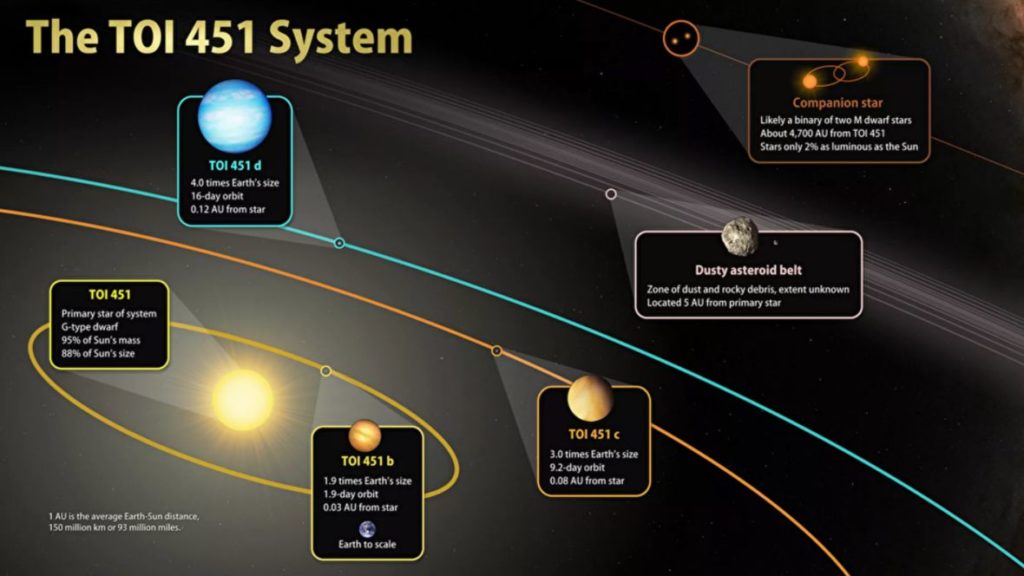NASA’s Transiting Exoplanet Survey Satellite – TESS – has confirmed the presence of three exoplanets that may be useful for studying how atmospheres form and develop over time.
The three exoplanets, each slightly larger than ours, were detected orbiting a much younger version of our Sun called TOI 451, located about 400 light-years away in the constellation Eridanus.
The star has 95% the mass of our Sun, is 12% smaller and emits 35% less energy. In addition, it spins five times faster than our parent star, which is a much more intense environment for its fledgling star system.

Its farthest planet orbits three times closer than Mercury approaches our Sun, so each of these planets is extremely hot and almost certainly uninhabitable for life as we know it, at atmospheric temperatures ranging between 1,200 and 450 degrees Celsius.
Scientists hope that, despite the intense heat and crushing proximity to their star, these exoplanets will continue to conserve their atmospheres and can serve as useful examples to study the formation and development of the atmosphere over time, even in extreme circumstances.
- Does This Mean We Stopped Being Animal and Started Being Human Due to ‘Copy Paste’ Errors?
- The One Lifestyle Choice That Could Reduce Your Heart Disease Risk By More Than 22%
- Aging: This Is What Happens Inside Your Body Right After Exercise
- Immune-Boosting Drink that Mimics Fasting to Reduce Fat – Scientists ‘Were Surprised’ By New Findings
- Gun Violence in America: What They Don’t Talk About at the Debate
“Since there are three planets two to four times the size of Earth, they are especially promising targets for testing theories about the evolution of planetary atmospheres”
explained Elisabeth Newton, associate professor of physics and astronomy at Dartmouth College in New York. New Hampshire, which led the investigation.
Observing the starlight passing through the atmospheres of these planets offers an opportunity to study this phase of development and could help narrow down current models of the evolution of atmospheres.
“By measuring the light from the stars that penetrates the atmosphere of a planet at different wavelengths, we can infer its chemical composition and the presence of high-altitude clouds or mists,” said Elisa Quintana, an astrophysicist at the Goddard Space Flight Center of NASA in Greenbelt, Maryland.
- Does This Mean We Stopped Being Animal and Started Being Human Due to ‘Copy Paste’ Errors?
- The One Lifestyle Choice That Could Reduce Your Heart Disease Risk By More Than 22%
- Aging: This Is What Happens Inside Your Body Right After Exercise
- Immune-Boosting Drink that Mimics Fasting to Reduce Fat – Scientists ‘Were Surprised’ By New Findings
- Gun Violence in America: What They Don’t Talk About at the Debate
“The planets of TOI 451 offer excellent targets for such studies with Hubble and the upcoming James Webb Space Telescope.”
The planets’ signatures were initially detected in December 2018 and subsequently confirmed by numerous analyzes, using some of the most powerful telescopes and observatories on Earth.
Exoplanets are found in the Pisces-Eridanus stellar stream that is less than 3% the age of our solar system and encompasses a third of the sky visible from Earth.
“It is only 120 million years old and only 400 light-years distant, allowing for detailed observations of this young planetary system,” Newton said.
NASA researchers assume that the system retains a cold disk of dust and rock debris, and it may also have two stellar companions spinning around each other in an orbit far beyond the planets. This makes it a useful example for studying the evolution of nascent star systems that could provide information about our own system.
The discovery is expected to provide additional information on how atmospheres around nascent planets form in the universe, which could help refine the search for habitable worlds for colonization as well as intelligent extraterrestrial life.
